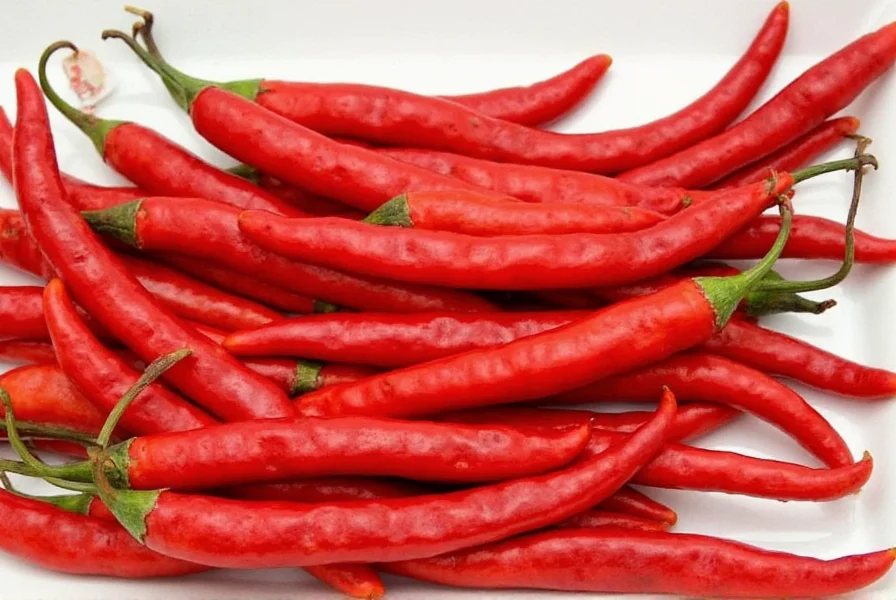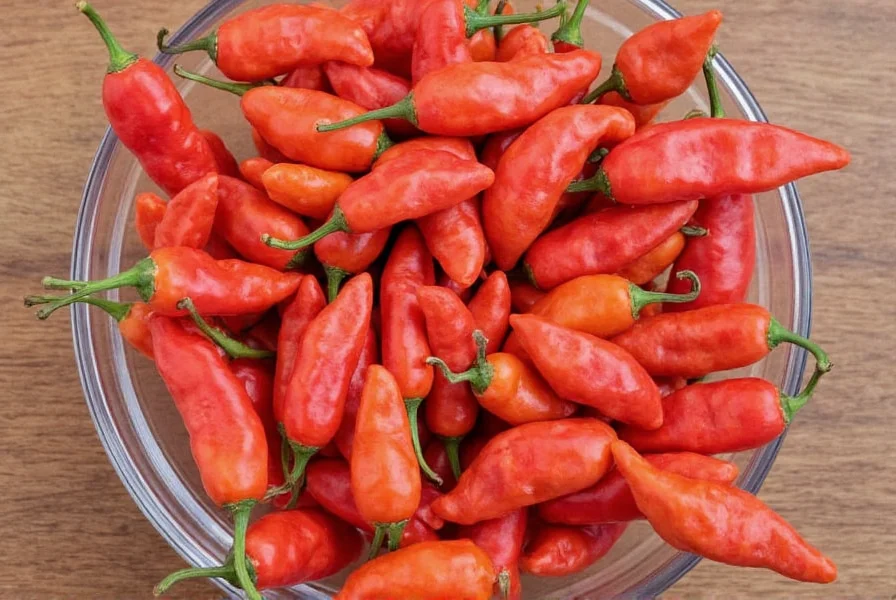The Cerrano chile (also known as chile de cerro) is a small, fiery pepper native to Mexico, particularly the regions of Veracruz, Puebla, and Oaxaca. Known for its intense heat (20,000–50,000 Scoville Heat Units) and bright, citrusy flavor, it's a staple in Mexican cuisine. This comprehensive guide covers everything you need to know about Cerrano chiles, including heat levels, flavor profile, cooking uses, buying tips, substitutes, storage, and more.
Table of Contents
- What Exactly Is a Cerrano Chile?
- How Hot Is It? Scoville Scale Breakdown
- Flavor Profile: What Makes It Special?
- Top 5 Ways to Use Cerrano Chiles in Cooking
- Buying Guide: How to Choose the Best Cerrano Chiles
- Substitute Showdown: When Cerrano Isn't an Option
- Storage & Preservation Tips
- FAQ Section: Your Burning Questions Answered
- Conclusion: Why Cerrano Deserves a Spot in Your Pantry
What Exactly Is a Cerrano Chile?
The Cerrano chile (or chile de cerro) comes from Mexico, specifically from regions like Veracruz, Puebla, and Oaxaca. Named after the hills ("cerros") where it grows wild, this small green or red chile is known for its intense heat and bright flavor. Unlike jalapeños, which are commonly found in U.S. grocery stores, Cerranos aren't as mainstream—yet they offer so much more punch.
It's typically used fresh, dried, or even pickled in vinegar (called "tajín"), making it incredibly versatile in the kitchen. But don't be fooled by its size—it packs a powerful punch that can rival even habaneros on a good day!
How Hot Is It? Scoville Scale Breakdown
| Pepper | Scoville Heat Units (SHU) |
|---|---|
| Jalapeño | 2,500–8,000 |
| Serrano | 10,000–23,000 |
| Cerrano | 20,000–50,000 |
| Habanero | 100,000–350,000 |

So yes, Cerrano is hotter than both jalapeños and serranos, sometimes even flirting with habanero territory depending on how it's grown and prepared. Keep that in mind when using it raw—this isn't a pepper for the faint-hearted!
Flavor Profile: What Makes It Special?
Beyond the heat, the Cerrano chile brings a bright, grassy, and slightly citrusy flavor to dishes. Unlike some super-hot peppers that sacrifice taste for spice, Cerrano balances both beautifully. Its crisp texture when fresh makes it ideal for salsas, while drying enhances its earthiness—perfect for moles and stews.
When pickled, Cerrano gains a tangy edge that pairs wonderfully with tacos al pastor or grilled meats. And if you're into hot sauces, this pepper shines when blended with garlic, lime, and a touch of vinegar.
Top 5 Ways to Use Cerrano Chiles in Cooking
- Salsa verde extraordinaire: Blend fresh Cerrano with tomatillos, onion, garlic, and cilantro for a smoky-green salsa that will blow store-bought versions out of the water.
- Pickled Cerrano Tacos: Add a few slices of vinegar-pickled Cerrano to your next taco creation for a tangy kick that elevates everything from carnitas to veggie fillings.
- Hot Sauces: Roast Cerrano with onions and tomatoes, then puree for a fiery sauce that goes great on eggs, grilled cheese, or even pizza.
- Chili Oil Infusion: Infuse oil with sliced Cerrano for a DIY chili oil that adds instant zing to noodles, stir-fries, or bread dips.
- Mole Base Booster: Dried and ground Cerrano can add depth and subtle heat to mole sauces, especially those made with chocolate or nuts.
Buying Guide: How to Choose the Best Cerrano Chiles
Spotting authentic Cerrano chiles at your local market might be a bit tricky, but here are some tips to help you find quality ones:
- Fresh vs. Dried: Fresh Cerrano should be firm, glossy, and without wrinkles or blemishes. Dried ones should have deep color and no signs of mold or moisture.
- Color: Green Cerrano is more vegetal and milder; red ones are spicier and more mature. Choose based on your dish and desired heat level.
- Where to Buy: Specialty Mexican markets, Latin grocery stores, and online spice retailers often carry real Cerrano chiles.

Recommended Products Featuring Cerrano Chile
Tapatío Cerrano Hot Sauce
- Features: Balanced heat with a sharp, clean finish.
- Advantages: Great for drizzling over tacos, burritos, or breakfast foods.
- Use Case: Ideal for everyday use and spice newbies wanting to test the waters.
- Target Audience: Home cooks, street food lovers, and hot sauce collectors.
- Suitable Occasions: Brunches, taco nights, and quick lunch bowls.
La Costeña Dried Cerrano Pack
- Features: High-quality, sun-dried Cerrano chiles vacuum-packed for freshness.
- Advantages: Long shelf life, easy to rehydrate and use in traditional recipes.
- Use Case: Perfect for moles, soups, and slow-cooked dishes requiring depth of flavor.
- Target Audience: Serious home cooks and Mexican cuisine enthusiasts.
- Suitable Occasions: Holiday meals, family dinners, and weekend meal prep.
Substitute Showdown: When Cerrano Isn't an Option
| Substitute | Similarities | Differences |
|---|---|---|
| Serrano Pepper | Nearly identical look and heat profile | Milder flavor and less availability in dried form |
| Hatch Green Chile | Great roasted flavor | Less heat, more sweetness |
| Jaloro Pepper | Bright yellow-green color and moderate spice | Not as intense or earthy as Cerrano |
| Guajillo Pepper (dried) | Common in moles and rich sauces | Smother, more fruity flavor with less heat |
Storage & Preservation Tips
Want your Cerrano chiles to last longer? Here's how to keep them fresh and flavorful:
- Fridge: Store unwashed Cerrano chiles in a plastic bag for up to two weeks.
- Freeze: Wash and freeze whole chiles in a sealed bag. They'll retain flavor and heat indefinitely.
- Drying: String them up or lay them flat in a dry, sunny spot until fully dehydrated.
- Pickling: Preserve them in vinegar with garlic, salt, and spices for up to six months.
FAQ Section: Your Burning Questions Answered
After researching common questions about Cerrano chiles, we've compiled the most frequently asked questions to help you become a true Cerrano expert:
What's the difference between Cerrano and serrano peppers?
While they sound similar and share some visual characteristics, Cerrano and serrano peppers are distinctly different. Cerrano chiles typically run hotter (20,000-50,000 SHU) compared to serranos (10,000-23,000 SHU). Cerranos have a brighter, more citrusy flavor profile, while serranos tend to be more vegetal. Cerranos grow wild in Mexican hill regions (cerros), whereas serranos are more commonly cultivated.
How can I handle Cerrano chiles safely without burning my skin?
Always wear gloves when handling Cerrano chiles, especially when cutting or seeding them. The capsaicin oils can cause significant skin irritation. If you do get oil on your skin, wash immediately with soap and cool water—avoid touching your face or eyes. Never use hot water, as it can open pores and increase absorption of the oils.
Are Cerrano chiles good for pickling?
Absolutely! Cerrano chiles are excellent for pickling and are commonly preserved this way in Mexican cuisine (known as "tajín"). Their firm texture holds up well to vinegar, and the pickling process tames their intense heat while preserving their bright flavor. Try pickling them with garlic, oregano, and black peppercorns for a versatile condiment that lasts up to six months.
Can I grow Cerrano chiles at home?
Yes, though they can be more challenging than common varieties. Cerrano plants prefer warm climates with plenty of sun (at least 6-8 hours daily). They need well-draining soil and consistent watering—letting the soil dry slightly between waterings. Start seeds indoors 8-10 weeks before your last frost date. Be patient, as Cerrano peppers can take 90-120 days to mature. In cooler climates, grow them in containers that can be moved indoors during colder months.
How can I reduce the heat of Cerrano chiles in my dishes?
To reduce heat while maintaining flavor, remove the seeds and white membranes (placenta) where most capsaicin concentrates. Cooking methods also affect heat: roasting or grilling can mellow the spice, while raw applications will be hottest. Adding dairy (like sour cream or cheese), acid (lime juice), or sweetness (a touch of honey) can balance the heat. Remember that dried Cerranos are significantly hotter than fresh ones—use about half the amount when substituting dried for fresh.
Conclusion: Why Cerrano Deserves a Spot in Your Pantry
There you have it—your complete lowdown on the Cerrano chile. From its explosive heat to its vibrant flavor and versatility, this pepper deserves more recognition. Whether you're blending it into sauces, pickling it for tacos, or adding it to moles for a hidden kick, the Cerrano chile can truly transform your cooking.
So next time you're wandering through a market or browsing online spice shops, keep your eyes peeled for these fiery little gems. Once you try them, there's no going back!










 浙公网安备
33010002000092号
浙公网安备
33010002000092号 浙B2-20120091-4
浙B2-20120091-4